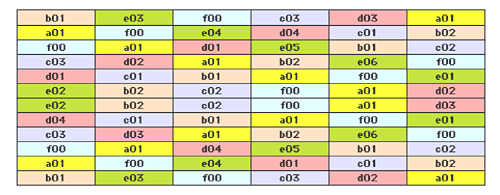(Click on any image below to view a larger version of the image.)
Firstly, a fascination with the start of a poem by Fanny Howe:
disintegrating.
Secondly, a concern with the dense formal organization of Chinese parallel verse, most specifically in how every element in a parallel couplet rhymes semantically with its counterpart, as well as fulfilling certain phonetic constraints.
Thirdly, an interest in how many ways rhyme, both semantic and phonetic, might be implemented in English.
Fourthly, an entry on Ireland in the 1842 edition of the Encyclopaedia Britannica.
The exact parallelism possible in Chinese tends towards tedium in English verse, and yet makes available new possibilities whereby a poem may mean. I tried to construct a verse-form in which every element would be rhymed but with significant differences from the Chinese:
- systematically vary the pattern of rhyming in sucessive lines rather than echoing the exact order
- rhyme not just two elements, but sometimes many more
- use many different sort of rhyme
- allow each element to be filled out with words of secondary weight, as the texture of English verse is less telegraphic than Chinese
Having also a long-established taste for bi-cameral texts, in which the two parts are in ambivalent relation to each other, I made a prose collage using the encyclopaedia entry as a base.
Then, fixing on the number twelve as suitable, I set up a pattern of rhyming. There would be twelve stanzas, each with six elements, the number twelve having six factors (1, 2, 3, 4, 6, 12).
This determined that there would be one rhyming-chain of twelve elements, two chains of six elements each, and so on, down to six chains of two elements each. I also had twelve one-element chains, equivalent to a wild-card in each stanza, an element which should rhyme only with itself.
Given all this, I set up the structure of rhyming as follows:
The colours here are purely to make the pattern more easily visible. Evidently, the second half is a mirror-image of the first.
Next was to fix on the rhyme-words. Starting with the line from Fanny Howe I chose the word “disintegrating” and set about reverse engineering the poem from that. In its original context, I take it to function intransitively. Deliberately, I perverted that, and chose to interpret it as meaning “to break something up.” This provided the seed-word for the longest and most important rhyme-chain.
An old list of terms from renaissance butchery gave the eleven rhymes: you tusk a barbel, splay a bream, frush a chicken, untache a curlew, disfigure a peacock, unbrace a mallard, tranch a sturgeon, culpon (or coupon) a trout, leach brawn, break a deer and splat a pike.
Other rhyme chains were constructed on other bases: three dances with animal names (foxtrot, bunny hug, pavan [= peacock]); four terms from iron-founding (bloom, sow, loop, cast); the six realms of being in medieval Japanese Buddhism; the verbs occurring last in each of the four paragraphs of the accompanying prose, et al. Here they all are, with column f reserved for the wild-card elements:
All that remained was to smooth the run of the poem with inflected forms, secondary “empty” words, etc, and to preserve the overall ‘rhyme’ between the struggle to take off one’s clothes, and the difficulty experienced in being disfigured.

